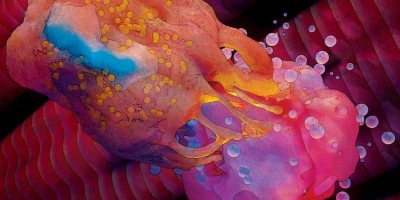Endothelial cell–cell contacts in blood vessels constitute a barrier to the flux of molecules and cells from blood to tissues. We identified the tyrosine-protein kinase Yes as the principal regulator of collective endothelial cell migration and vascular barrier dynamics, a finding that opens avenues for future therapeutic development.

References
Szymborska, A. & Gerhardt, H. Hold me, but not too tight–endothelial cell–cell junctions in angiogenesis. Cold Spring Harb. Perspect. Biol. 10, a029223 (2018). A review article on the molecular mechanisms that govern endothelial cell–cell adhesion in the context of vascular development.
Claesson-Welsh, L., Dejana, E. & McDonald, D. M. Permeability of the endothelial barrier: identifying and reconciling controversies. Trends Mol. Med. 27, 314–331 (2021). A review article on recent advances in cellular and molecular processes that regulate the vascular barrier in health and disease.
Adam, A. P. Regulation of endothelial adherens junctions by tyrosine phosphorylation. Mediators Inflamm. 2015, 272858 (2015). A review article that presents studies on the regulation of the vascular barrier through tyrosine phosphorylation.
Orsenigo, F. et al. Phosphorylation of VE-cadherin is modulated by haemodynamic forces and contributes to the regulation of vascular permeability in vivo. Nat. Commun. 3, 1208 (2012). This paper reports on flow-regulated phosphorylatoin of VE-cadherin through the activation of Src.
Wessel, F. et al. Leukocyte extravasation and vascular permeability are each controlled in vivo by different tyrosine residues of VE-cadherin. Nat. Immunol. 15, 223–230 (2014). This paper reports on different tyrosine residues of VE-cadherin that control distinct cellular behaviors.
Additional information
Publisher’s note Springer Nature remains neutral with regard to jurisdictional claims in published maps and institutional affiliations.
This is a summary of: Jin, Y. et al. Tyrosine-protein kinase Yes controls endothelial junctional plasticity and barrier integrity by regulating VE-cadherin phosphorylation and endocytosis. Nat. Cardiovasc. Res. https://doi.org/10.1038/s44161-022-00172-z (2022).
Rights and permissions
About this article
Cite this article
Tyrosine-protein kinase Yes is essential in vascular barrier dynamics. Nat Cardiovasc Res 1, 1136–1137 (2022). https://doi.org/10.1038/s44161-022-00195-6
Published:
Issue Date:
DOI: https://doi.org/10.1038/s44161-022-00195-6
- Springer Nature Limited


